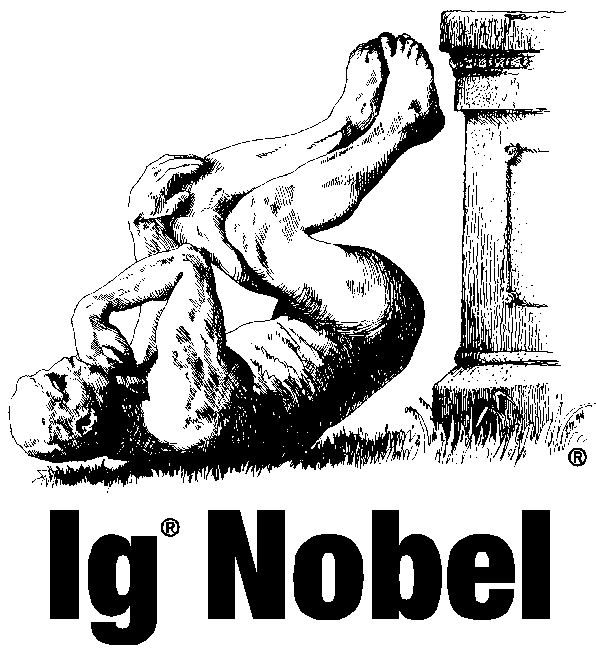(Note: At this event I will have a petition to sign, supporting my push to create a state historical marker honoring the birth of BASIC. That makes two reasons to show up!)
Every cat owner knows that felines don’t obey the rules of physics. Every chef knows that dry spaghetti noodles never break in half.
And everybody who has ever had an itch knows you can fix it by scratching the wrong place, as long as you’re looking in a mirror.
Wait – you don’t know that? You need to catch up on your Ig Nobel prizes, my friends, because all three of those have won this prestigious (for certain definitions of the word “prestigious”) science award.
You can catch up at the actual awards this year, although the Ig Nobel Awards in Boston on Sept. 13 are very nearly sold out. But have no fear, there’s a great fallback: Come to next week’s Science Cafe New Hampshire in Concord, in which we will kick off our eighth season with a slightly different event.
Marc created the Igs as a sort of offshoot to his creation the Annals of Improbable Research, a parody science journal, and I think he has been surprised by its impact. Most winners show up to accept their award in person, even if they’ve had to fly in from as far away as Japan or Scandinavia, and most include it prominently on their resume.
A better example: When Andrew Geim won the 2010 Nobel Prize in physics, more than one news article noted quite prominently that he was the first person to have won both a Nobel Prize and an Ig Nobel Award. (He won his Ig in 2000 for using magnets to levitate a frog.)
This year’s Igs will happen Sept. 13 in their usual home, the gorgeous Sanders Theater at Harvard University. If past events are any guide, it will feature real Nobel laureates from Harvard, MIT and elsewhere acting silly (for years the on-stage janitor, quietly sweeping during the whole event, was physics laureate Roy Glauber); enough paper airplanes thrown by the audience to fill a Cessna; professional singers performing a mini-opera about something scientific-ish (e.g., “La Kaboom Grosso” concerned the Big Bang); and 10 awards given to real scientific research that contain a certain something which makes it Ig Nobel-worthy.
What’s Ig-worthy? Let’s look at those broken spaghetti noodles.
The 2006 Ig Nobel physics prize went to a paper titled “Fragmentation of rods by cascading cracks: Why spaghetti does not break in half.”
Many folks, including famous physicist Richard Feynman, have been puzzled by the fact that dry spaghetti shatters into three or more pieces no matter how carefully you try to break it. The winning paper, published in the journal Physical Review Letters, studied the matter. It is sprinkled with sentences like “the dynamics of thin rods are described by the celebrated Kirchhoff equations in which the limit of small planar oscillations take the form: L 4 K, S4 (s,t) + T 2 K, T2 (s,t) = 0, (1) where a comma in indices denotes a partial derivative” and concludes that the “non-intuitive” behavior of something called flexural waves is to blame.
The appeal to Marc is obvious: It’s science but it’s a funny-sounding thing to study plus it gave the excuse to bust a bunch of noodles on stage. (Thank goodness for in-show janitors.)
But it’s also real science that can lead to real improvements in engineering and design. And it still has long-lasting appeal. This summer two MIT students announced that after a lot of mathematical modeling and experimentation, they had found a way to break dry noodles in only two pieces: The key is to twist them while you’re bending them.
Another example is that award about scratching yourself that I mentioned earlier. This 2016 Medicine Prize winner was real science, analyzing the psychological effect in which for some people, “if you have an itch on the left side of your body, you can relieve it by looking into a mirror and scratching the right side of your body (and vice versa).”
Intriguing, interesting – but also funny and a source for good on-stage visuals.
However, not all Ig prizes are given to work that is serious. The 2017 physics winner, for example, analyzed the “fluid dynamics of cats” in order to determine whether they can transition from solid to liquid state, a tongue-in-cheek analysis of how our feline pets often squeeze themselves into too-small boxes.
And not all Ig prizes go to science. Marc occasionally uses an award to make a point, giving pointed, sarcastic prizes to nonsense like homeopathy and creationism, or to corporate misbehavior by the likes of Volkswagen and big banks.
You can read the list of all winners online (improbable.com/ig/winners) with links to learn more about such past winners as “using advanced brain-scanning technology to measure the extent to which some people are disgusted by cheese,” “investigating whether things look different when you bend over and view them between your legs” and “determining whether and how Moulay Ismael the Bloodthirsty, the Sharifian Emperor of Morocco, managed during the years from 1697 through 1727 to father 888 children.” (Sex and bodily fluids show up frequently in Ig Nobel winners.)
If all this sound intriguing, I’ll see you next Tuesday, Sept. 4, at The Draft Sports Bar, 67 S. Main St., from 6-8 p.m. It’s free, of course.


 Return to the Concord Monitor
Return to the Concord Monitor